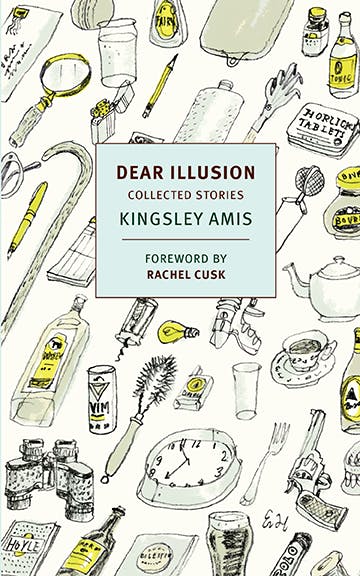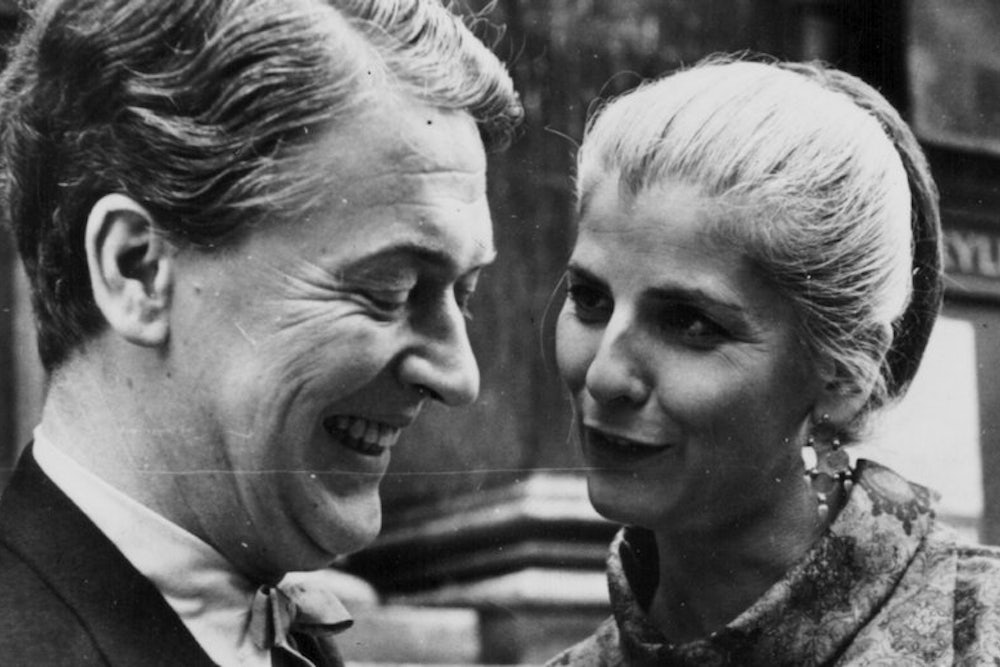What is today’s reader offered by the work of Kingsley Amis? This may not seem an especially pertinent question to ask of a writer who only died in 1995, but in art the recent past can sometimes appear more outmoded and inaccessible than distant history. The living writer is close to the common well of experience; once the writer has died, and can no longer articulate our contemporary world for us, he is exposed to the more brutal judgment of time. What in his work is timeless? What, if anything, makes it worth preserving?

Of course, definitive answers to these questions aren’t always found: dead writers continue to go in and out of fashion, their work suddenly meaningful again in one era then failing to make sense in the next. It is often the most passionately contemporary writers—Kingsley Amis was one—whose reputations decline most steeply in their absence, for obvious reasons. Relevance becomes irrelevance; the same devotion to the here and now that brought them popularity and fame ensures their obscurity once here and now have become there and then. Yet the observation of ordinary life nearly always forms the cornerstone of great and lasting art. It is the quality of that observation that is put to the test over time, that will determine whether the work is trivial or lastingly true.
Kinglsey Amis made his name in the 1950s with the publication of his first novel, Lucky Jim, a work that seemed to define a new era not just in its portrayal of the evolving world of higher education that is its setting but in literary values too, advancing as it did a more youthful and democratic conception of literary style and subject matter that reflected changing modes of social behavior. In Lucky Jim Amis reprised the black comedy of Evelyn Waugh and re-clothed it in the provincial workaday garb of the ordinary middle classes, and if in doing so he belied something of his artistic seriousness, he was rewarded for it with instant acclaim. His story of a young provincial-university lecturer’s sufferings at the hands of academic bores, pretentious snobs, prissy disapproving women and spoiled culturally elitist young men was a huge commercial and critical success. It laughed at everyone who needed laughing at in that cramped, class-bound decade; it gave a likeable validity to the new forms of life, to social and sexual freedoms it showed as modest, funny, authentic.
Amis was himself a university lecturer during this period—he taught at Swansea, where he lived for many years with his wife and three children—and so he knew whereof he wrote. Indeed, the integrity of Lucky Jim, and of Amis’s work generally, derives from its autobiographical impulse. Though he wrote assiduously in different forms and genres—he considered himself a poet first and a novelist second—it is for its hold on unadorned life that his writing was and is esteemed. Yet if Amis kept close to the sources of his own experience, it may partly have been out of a kind of humility, almost a shyness in the face of questions of art. Self-deprecation, usually in the guise of comedy, is a hallmark of an Amis project; humor was his mode of attack and of address. And if humor is also a defense, against, among other things, the accusation that one is taking oneself too seriously, Amis may have relied on his identity as a comic writer to shield him from the larger consideration—both private and public—of his stature as an artist.
Nowhere is this clearer than in his handling of the short story form, whose particular possibilities for advancing the representation of modern experience he understood and acknowledged while firmly distancing himself from them: “the things that only the short story can do,” he wrote, “the impression, the untrimmed slice of life, the landscape with figures but without characters, make little appeal to me.” His own stories, he said, were mere “chips from a novelist’s work-bench.” He goes on, more revealingly, to observe that the contemporary short story tends to be published in “those pale and sickly present-day equivalents of the Victorian fiction magazines, the periodicals subsidized by the Arts Council or one of its offspring. A writer, or any other kind of artist, who partly or largely need not depend on pleasing the public, who in effect has his fee guaranteed whatever the quality of his product, is tempted to self-indulgence and laziness.” Better to stick to the novel, “which as yet is unlikely to contain any material subsidized by the Arts Council.”
Amis’s fear of art being viewed as pretense and the artist as lazy or dependent is clear from these remarks; and who would accuse an artist of being lazy? The answer might be: a working man. With his talk of product and workbenches, Amis is trying to create the image of the writer as an ordinary worker, to dispel art’s associations with foppishness and pretentiousness and self-aggrandizement. These associations were evidently painful to Amis—but why? It is as though, in the modernist possibilities of the short story, he perceived a threat both to his masculine and his writerly identity; yet for a generation of American male writers emerging contemporaneously with Amis, the short story was a sort of "working man’s"—indeed almost a macho—form. The story-writer Amis claimed most to admire was Rudyard Kipling: despite being hailed as an innovator with Lucky Jim, Amis’s anxiety was after all perhaps that of being thought old-fashioned. As far as the short story was concerned, he may have affixed that label to himself before anyone else could do it for him.
Any reader for whom these stories constitute the first encounter with Amis’s work will find them nonetheless to be a sample-case of his qualities as a writer. As his remarks about the short story suggest, he did not take either himself or the form in new directions; instead, he brought to it valuable fragments of his gift, “chips from a novelist’s work-bench.” Chief among these is his vigorous observational prose, so assertive and deft and concise:
The Mess occupied a Belgian provincial hotel and this was its lounge, a square room lined with burst leather-padded benches. Officers sat on them reading magazines. Only the fact that two or three or them were also drinking stopped the place looking like a barber’s waiting-room. Outside it was raining a little.
And of course the astringent of humor, cutting and re-cutting the description as though in the (unfounded) fear that it might be found over-rich, or worse, over-serious:
The part of Frank that could be seen above the back of the pew seemed to Alec to offer a good deal of information. The thick black hair was heavily greased; the neck bulged in a way that promised a roll of fat there in due course; the snowily white shirt- collar and the charcoal-grey suit material did somehow or other manage to suggest, not lack of taste exactly, but the attitude that money was more interesting.
These stories, spanning Amis’s career, also of course span his interests and preoccupations, his choices and changes of subject matter, his formal experiments, his writerly moods and declensions, his tics and trademarks. There are army stories, literary genre stories (sci-fi, plus a Sherlock Holmes spoof from which Sherlock Holmes is absent), as well as stories about literature (in Mr Barrett’s Secret, Elizabeth Barrett Browning’s father discloses his reasons for his estrangement from his daughter after her marriage to the poet); and then there are stories that are more than chips from the work-bench, stories in which Amis’s piquancy as an artist, his essence, can be experienced, such as Moral Fibre, All the Blood Within Me and Dear Illusion.
This essence, composed as it is of social frustration, fleshly appetite, critical disquiet and the sometimes painful bridling of personal emotional power, is most detectable in Amis’s portrayals of relationships, where his hilarious, faintly misanthropic grasp of human character ("The first person he saw on entering the dining-car was Bob Anthony, wearing a suit that looked like woven vegetable soup and reading a newspaper with awful concentration") creates scenes whose bristling surface activity conceals undercurrents of profound desolation, of alienation and loneliness, of despair at the meagerness of the world’s offerings. Amis’s characters, generally speaking, aren’t glamorous or liberated or even particularly empowered; mostly they are entrapped at the local level of British life in the second half of the twentieth century, subject to the grating irritations of the ordinary. Few writers of Amis’s caliber observe their world from such a level today; and it is for his accounts of human pettiness and small-mindedness, of small-scale tyranny, of big emotions felt in exigent places, of the tensions of local shop and street and flat, that we should continue to read him.
In Moral Fibre, a domineering social worker encounters one of her charges in the narrator’s kitchen:
"Ah, good morning, Betty," Mair said bluffly. "How are you getting on? Do you like working for Mrs Lewis?"
"Aw, all right."
Mair’s lion-like face took on the aspect of the king of beasts trying to outstare its tamer. "I think you know my name, don’t you Betty? It’s polite to use it, you know."
At this I went out into the kitchen again, but not quickly enough to avoid hearing Betty saying, "Sorry, Mrs Webster," and, as I shut the door behind me, Mair saying, "That’s more like it, isn’t it, Betty?"
In All the Blood Within Me, a man attends the funeral of a woman he has loved and for decades conducted an affair with, an affair accepted within her marriage, to the extent that the two men are friends and may even live together now that she’s gone. With admirable delicacy Amis evokes the muted pain of this arrangement, and the confining suburban world in which it has occurred:
A handful of earth was thrown on to the coffin. Alec realized that he had been very afraid of the hollow noise this might make, but it was all right, the soil was dry and chalky, without noticeable clods, and when the spades got to work it could, from the sound, have been anything at all being buried. There were the beginnings of movement away from the graveside; Alec sighed and raised his head, and the whole scene shone brightly in his eyes: the people with their varied complexions and hair, the grass, the privet hedges, the vases of red and blue flowers on the graves, the great pair of cypresses by the entrance, all slightly over-colored like a picture postcard.
What today’s reader, and indeed today’s writer, can learn from Amis is the value of the particular; a value that is higher now than ever, as the choices and possibilities for living become ever more homogeneous. It grows harder to represent by means of the particular—the perceptible detail—what makes people and places distinct from one another, what will signify their individuality. It may be old-fashioned to fear the decline of individuality; the writerly means of halting this decline may well be old-fashioned too. In the best of these stories Amis does so, constructing a solid surface of well-observed concrete fact, upon which the play of character through dialogue and voice can occur. One feels at such moments the presence of the novelist’s workbench, in all its utilitarian beauty.
Introduction to "Dear Illusion" by Rachel Cusk. Copyright © 2011 by Rachel Cusk, used by permission of The Wylie Agency LLC.
